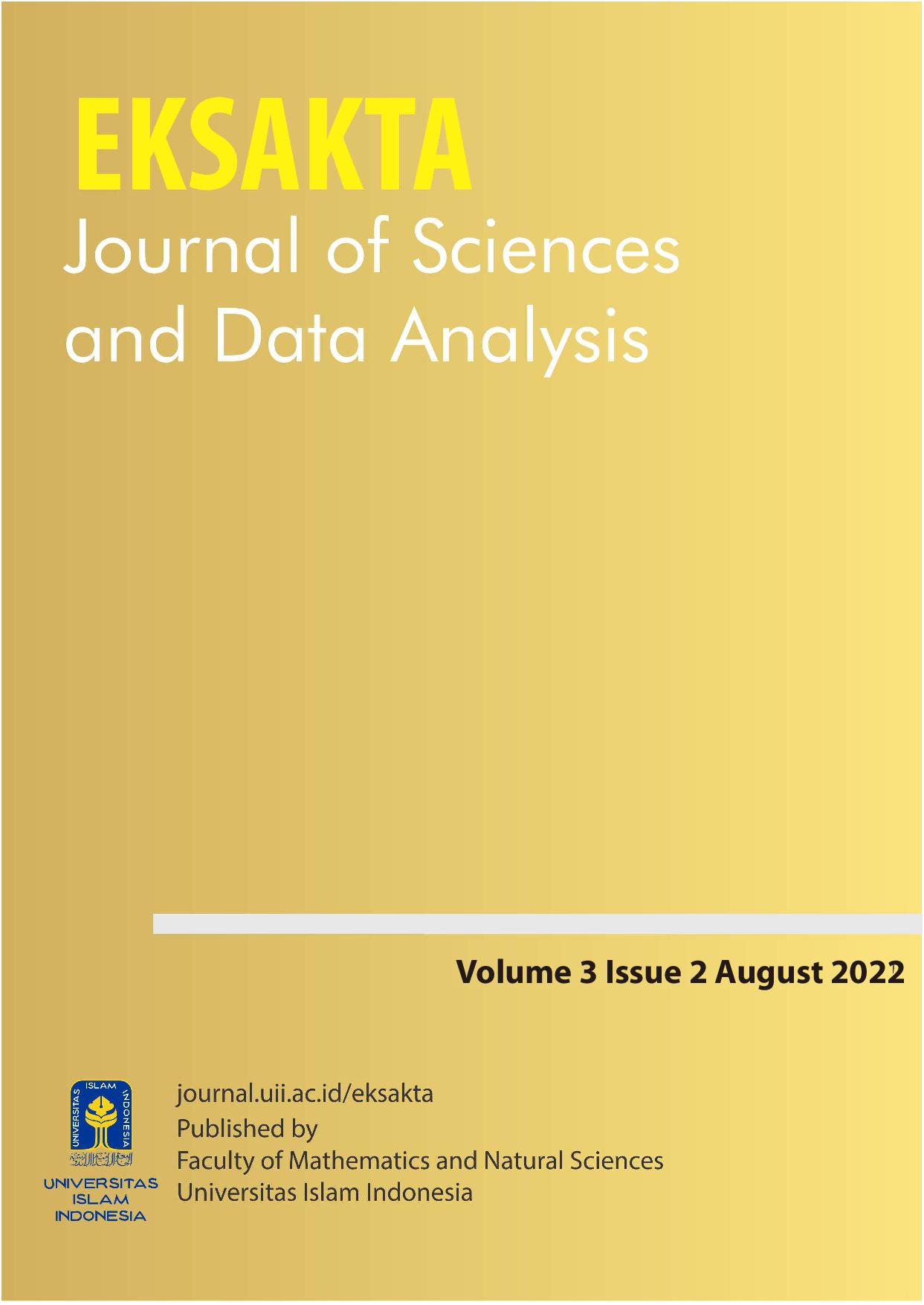Main Article Content
Abstract
Keywords
Article Details
Authors who publish with this journal agree to the following terms:
- Authors retain copyright and grant the journal right of first publication with the work simultaneously licensed under a Creative Commons Attribution License that allows others to share the work with an acknowledgment of the work's authorship and initial publication in this journal.
- Authors are able to enter into separate, additional contractual arrangements for the non-exclusive distribution of the journal's published version of the work (e.g., post it to an institutional repository or publish it in a book), with an acknowledgment of its initial publication in this journal.
- Authors are permitted and encouraged to post their work online (e.g., in institutional repositories or on their website) prior to and during the submission process, as it can lead to productive exchanges, as well as earlier and greater citation of published work (See The Effect of Open Access).
References
- R. N. Fajri, R. Putra, C. B. De Maisonneuve, A. Fauzi, Yohandri, and H. Rifai, Analysis of magnetic properties rocks and soils around the Danau Diatas, West Sumatra, J. Phys. Conf. Ser., 1185(1) (2019).
- A. S. Ariani, A. D. Haryanto, J. Hutabarat, and Yudhicara, Karakteristik geokimia abu vulkanik gunung krakatau, Padjadjaran Geoscience Journal, 3(1) (2019) 38–43.
- Muliani, Mila, Klasifikasi Jenis Batuan Beku Berdasarkan Tekstur dengan Metode Transformasi Curvelet dan K-Nearest Neighbor (K-NN), e-proceeding of engineering, 4(2) (2017).
- V. C. Lopes and H. T. Wibowo, Pemetaan potensi pasir besi di desa umbulsari dan sekitarnya kecamatan tempursari kabupaten lumajang propinsi jawa timur 1,2, Seminar Nasional Sains dan Teknologi, 4(1) (2016) 159–168.
- E.D. Ningsih, R. Putra, C. D. L. Maisonneuve, M. Phua, S. Eisele, F. Forni, J. Oalmann, H. Rifai, Identification of Magnetic Mineral Forming Elements in peatland Alahan Panjang West Sumatra Indonesia, section DD REP B 693 using X-Ray Fluorescence, J. Phys. Conf. Ser., 1481(1) (2020) 1742-6596.
- J. Wulandari, Asrizal, Zulhendri, S. Bijaksana, Analisa mineral magnetik dalam masalah lingkungan, Jurnal Geofisika, 8(1) (2016) 57–64.
- L. D. Nanda, F. Tan, and M. Noer, Tingkat Partisipasi Masyarakat Dalam Program Penyelamatan Dan Pengelolaan Lingkungan Berkelanjutan Danau Maninjau, Jurnal Kebijakan Sosial Ekonomi Kelautan dan Perikanan, 8(2) (2019).
- S. Zulaikah, Prospek dan Manfaat Kajian Kemagnetan Batuan pada Perubahan Iklim dan Lingkungan, J. Fis. Unnes, 5(1) (2015).
- V. K. Gribkoff and L. K. Kaczmarek, Structure, Function, and Modulation of Neuronal Voltagegated Ion Channels, Structure, Function, and Modulation of Neuronal Voltagegated Ion Channels, (2008) 1–475.
- A. Peccerillo and S. R. Taylor, Geochemistry of eocene calc-alkaline volcanic rocks from the Kastamonu area, Northern Turkey, Contrib. to Mineral. Petrol., 58(1) (1976) 63–81.
- J. Hutabarat, Geokimia Batuan Volkanik Formasi Cikotok Di Segmen Utara Kubah Bayah, Banten, Bull. Sci. Contrib., 14(2) (2016) 195–204.
- A. Andreas and A. Putra, Perbandingan Karakteristik Batuan Beku Erupsi Gunung Gamalama dan Gunung Talang, J. Fis. Unand, 7(4) (2018) 293–298.
- G. Mibei, Introduction to Types and Classification of Rocks, Short Course IX on Exploration for Geothermal Resources, (2014).
- Draniswari, Windi Anata, Peran Kontaminasi Kerak pada Diferensiasi Magma Pembentuk Batuan Vulkanik Sungai Amplas, Mamuju, Sulawesi Barat, Eksplorium, 4(73-86) (2020).
- O. Verdiansyah, Perubahan Unsur Geokimia Batuan Hasil Alterasi Hidrotermal Di Gunung Wungkal, Godean, Yogyakarta, Kurvatek, 1(1) (2016).
References
R. N. Fajri, R. Putra, C. B. De Maisonneuve, A. Fauzi, Yohandri, and H. Rifai, Analysis of magnetic properties rocks and soils around the Danau Diatas, West Sumatra, J. Phys. Conf. Ser., 1185(1) (2019).
A. S. Ariani, A. D. Haryanto, J. Hutabarat, and Yudhicara, Karakteristik geokimia abu vulkanik gunung krakatau, Padjadjaran Geoscience Journal, 3(1) (2019) 38–43.
Muliani, Mila, Klasifikasi Jenis Batuan Beku Berdasarkan Tekstur dengan Metode Transformasi Curvelet dan K-Nearest Neighbor (K-NN), e-proceeding of engineering, 4(2) (2017).
V. C. Lopes and H. T. Wibowo, Pemetaan potensi pasir besi di desa umbulsari dan sekitarnya kecamatan tempursari kabupaten lumajang propinsi jawa timur 1,2, Seminar Nasional Sains dan Teknologi, 4(1) (2016) 159–168.
E.D. Ningsih, R. Putra, C. D. L. Maisonneuve, M. Phua, S. Eisele, F. Forni, J. Oalmann, H. Rifai, Identification of Magnetic Mineral Forming Elements in peatland Alahan Panjang West Sumatra Indonesia, section DD REP B 693 using X-Ray Fluorescence, J. Phys. Conf. Ser., 1481(1) (2020) 1742-6596.
J. Wulandari, Asrizal, Zulhendri, S. Bijaksana, Analisa mineral magnetik dalam masalah lingkungan, Jurnal Geofisika, 8(1) (2016) 57–64.
L. D. Nanda, F. Tan, and M. Noer, Tingkat Partisipasi Masyarakat Dalam Program Penyelamatan Dan Pengelolaan Lingkungan Berkelanjutan Danau Maninjau, Jurnal Kebijakan Sosial Ekonomi Kelautan dan Perikanan, 8(2) (2019).
S. Zulaikah, Prospek dan Manfaat Kajian Kemagnetan Batuan pada Perubahan Iklim dan Lingkungan, J. Fis. Unnes, 5(1) (2015).
V. K. Gribkoff and L. K. Kaczmarek, Structure, Function, and Modulation of Neuronal Voltagegated Ion Channels, Structure, Function, and Modulation of Neuronal Voltagegated Ion Channels, (2008) 1–475.
A. Peccerillo and S. R. Taylor, Geochemistry of eocene calc-alkaline volcanic rocks from the Kastamonu area, Northern Turkey, Contrib. to Mineral. Petrol., 58(1) (1976) 63–81.
J. Hutabarat, Geokimia Batuan Volkanik Formasi Cikotok Di Segmen Utara Kubah Bayah, Banten, Bull. Sci. Contrib., 14(2) (2016) 195–204.
A. Andreas and A. Putra, Perbandingan Karakteristik Batuan Beku Erupsi Gunung Gamalama dan Gunung Talang, J. Fis. Unand, 7(4) (2018) 293–298.
G. Mibei, Introduction to Types and Classification of Rocks, Short Course IX on Exploration for Geothermal Resources, (2014).
Draniswari, Windi Anata, Peran Kontaminasi Kerak pada Diferensiasi Magma Pembentuk Batuan Vulkanik Sungai Amplas, Mamuju, Sulawesi Barat, Eksplorium, 4(73-86) (2020).
O. Verdiansyah, Perubahan Unsur Geokimia Batuan Hasil Alterasi Hidrotermal Di Gunung Wungkal, Godean, Yogyakarta, Kurvatek, 1(1) (2016).




